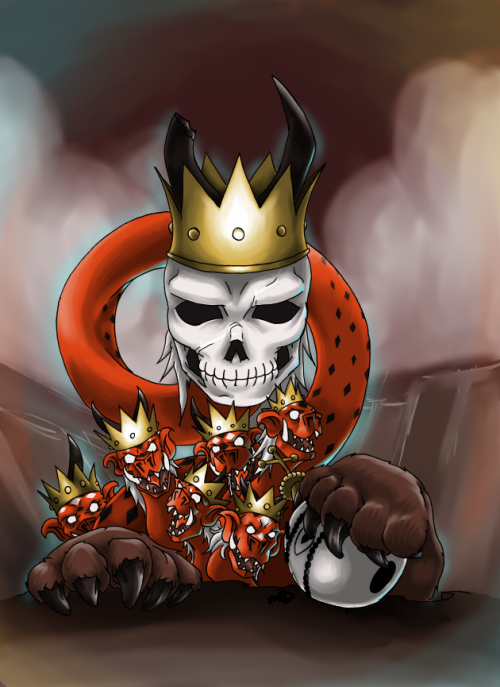Visit the art blog at thematicconversion.tumblr.com and the relog blog at evtrained.tumblr.com.
92 posts
05 Of 05 - Modern Compendium: Deity Family, Part 3 - Femme Chedipe

05 of 05 - Modern Compendium: Deity Family, Part 3 - Femme Chedipe
Throughout the Compendium, I’ve tried to include demons that speak not just to modern American sensibilities, but to various cultures all over the world. To that end, the Chedipe is a demon that has a lot to say about the recent history of India and the subcontinent.
The Chedipe is said to be a Vampire-like creature, a woman who seduces men and drains their blood. She sneaks into their rooms at night and drinks their lifeforce from their toes, returning night after night until her victim withers and dies. Legends say she can shapeshift into a tiger, leaping off into the night to escape pursuit, though one of her legs will always remain human. Chedipe are associated with devadasis, the dancing girls that once inhabited Hindu temples, but today these creatures are said to be born from any woman who dies an unnatural death, especially by childbirth.
The association the Chedipe has with devadasis is pretty significant to this demon’s history. See, back when the British colonized India, their utter lack of understanding of Indian culture caused a lot of friction. The British couldn’t tell the difference between devadasis who danced in the temples, and women who danced in the streets for money or for prostitution, so they lumped ‘em all together and outlawed the whole shebang. Between this and the destruction of the feudal lords that patronized temples, the devadasis were forced into the street, often into the very professions that the British had tried to eradicate by outlawing their art form.
I like to think that the Chedipe survived to the 21st century because it represents a memory of the injustices of colonial rule, as well as the lingering fear many women hold of being cast out of their homes with no real means of survival outside of prostitution.
The Chedipe is sometimes described as a witch or enchantress, whose shapeshifting abilities are evidence of some evil alliance. Between this and the demon’s aggressive, dangerous nature, the Chedipe fits neatly into the Femme family.
For more info on this and every other demon in the Modern Compendium, have a look at our Data File, right over (here).
-
 xxglitterdalambxx liked this · 4 years ago
xxglitterdalambxx liked this · 4 years ago -
 kinemax liked this · 8 years ago
kinemax liked this · 8 years ago -
 thedarkfiddler reblogged this · 10 years ago
thedarkfiddler reblogged this · 10 years ago -
 xerozohar liked this · 10 years ago
xerozohar liked this · 10 years ago -
 nagabenang liked this · 10 years ago
nagabenang liked this · 10 years ago -
 historyclasses reblogged this · 10 years ago
historyclasses reblogged this · 10 years ago
More Posts from Historyclasses

02 of 05 - Modern Compendium; Kishin Family, Part 3 - Genma Molly Pitcher
Say hello to our very first demon from the Genma family! In most Shin Megami Tensei games, the Genma family is home to demigods and half-human demons. The partially human aspect of this family is really fascinating, so I’ve given this part of the Modern Compendium over to figures from modern American folklore, which is unique in that it consists almost entirely of figures with superhuman powers, yet without an explicit connection to a god or gods.
Molly Pitcher is a particularly popular figure in American folklore. Supposedly, she was one of many women who followed their husbands off to war in the American Revolution. She worked on the battlefield tending the wounded and bringing water to the soldiers (hence Molly Pitcher), but when her husband fell in battle, she picked up his weapons and fought in his place.
Popular history says that Molly Pitcher was in fact an actual woman named Mary Ludwig Hays McCauley, who fought in the Battle of Monmouth in 1778. However, there are a huge number of stories that fit the general profile of Molly Pitcher tales, and the deeds of the woman in question have grown to superhuman proportions with retellings. This makes it likely that any stories you hear about Molly Pitcher are actually composites, built from the deeds of dozens of women, not just one.
Thanks to the enduring popularity of her story, Molly sits pretty snugly in the middle of the Genma family. Like most Genma, she’s primarily a physically offensive demon, but she does have some limited healing magic to throw around, too. All in all, she’s a very solid demon for the mid-game.
For more info on this and every other demon in the Modern Compendium, have a look at our extensive and ever-growing Data File, right over (here)!
(Incidentally I just wanted to mention that I briefly thought about designing Molly Pitcher to look like the Kool-Aid Man, as a reference to that goofy April Fool’s Day joke from a while back. But someone beat me to it. [link])

04 of 05 - Modern Compendium: Kishin Family, Part 3 - Haunt Flying Dutchman
One of the more unique ghost stories to be passed around in the last hundred years or so, the Flying Dutchman is one of the cornerstones of the traditional ghost ship story. Though it is fairly uncommon to come across someone who genuinely believes in the Dutchman these days, its mythology has been spread far and wide by sailors, and in modern times, by the series of Pirates of the Caribbean movies.
Tales of the Flying Dutchman may have begun circulating as early as the 17th century, but our earliest actual record of the ghost ship is from 1795, where George Barrington writes in his book, A Voyage to Botany Bay, about a Dutch ship that was lost off the Cape of Good Hope. Thereafter sailors would report a ghostly ship that would attempt to run them down, chasing them all the way to port before vanishing in a black cloud.
These stories were extremely popular for their time, but by the 20th century, people were eager to explain sightings of the Dutchman as drunken illusions on par with the manatees-turned-mermaids, or as a specific kind of mirage called a Fata Morgana, which creates a mirror image of a ship in the sky above the horizon.
Though not many people still believe in the existence of the Flying Dutchman, its mark on global culture is profound and unmistakable. This pedigree is more than enough to secure it a position at the top of the Haunt family.
For more information on and links to every demon in the Modern Compendium, have a look at our Data File, right over (here).

OUR ARRIVAL HAS BEEN ORDAINED
OURS IS THE FIRST SIGN, THE HERALD AND THE BLASPHEMY
THOSE WHO SEEK OUR COMING SHALL SEE US IN EVERY LORD
THEY SHALL SAY, “THIS MAN IS AN OUTSIDER, THIS WOMAN IS THE HARLOT”
THEY SHALL SEEK OUR SACRED NUMBER, AND TWIST TRUTH TO FIND IT WHERE IT IS NOT
YET OUR POWER EXISTS IN ALL PLACES WHERE MEN SEPARATE INTO “WE” AND “THEY”
WE ARE THE CONFLICT, AND THE PREDJUDICE, AND THE FEAR OF THE OTHER
YET ALL SHALL BEND TO THE WILL OF THE BEAST
EVEN YOU, HUMAN

01 of 05 - Modern Compendium; Kishin Family, Part 4 - Kishin Liberty
First off, I have to apologize; this was supposed to go up on the 4th. I always underestimate how busy the holidays can become. But the rest of the month’ll be full of Mom and Apple Pie, so it’s not a total loss. ^^
Anyway, Liberty! I actually considered doing Uncle Sam, but it turns out that Lady Liberty actually has a long – and I mean long – history behind her. Way back in Roman times, they worshiped a figure called Libertas, a goddess seen as so powerful that she was often equated with Sol Invictus, one of the central gods of the late Roman Empire.
The Statue of Liberty was a gift from France, where Liberty had come to prominence during the French Revolution. Hell, for a time Notre Dame was actually re-christened as a sort of temple to the “Cult of Reason,” and who did they turn to for a replacement for the Virgin Mary? Liberty.
The figure of the statue itself is actually used as a national personification by both the United States and France, where she is sometimes called Marianne. For a while, Americans knew her as Columbia, too, but that practice mostly fell by the wayside as Uncle Sam came to popularity in the 1930s and 40s.
Liberty is an incredibly popular figure in modern society. She’s appeared on everything from money to postage stamps to little souvenir figurines. And if having your likeness in millions of homes isn’t worship, I don’t know what is. Liberty is incredibly powerful, but she’s actually the second highest level Kishin. And the one demon above her is… Special.
For more information on this and every other demon in the Modern Compendium, have a look at our mysterious Data File, right over (here).

04 of 05 - Modern Compendium: Kishin Family, Part 4 - Genma Johnny Appleseed
I usually try to shy away from including figures in the Compendium that were actual people, but much like Tokisada in SMTIV, Johnny Appleseed sits at such a crossroad of mythology and culture that his omission would be glaring.
Born in the late 18th century as John Chapman, Johnny Appleseed is unique in the company of modern American folklore in that most of the stories told about him are in fact true. He did travel most of the United States of his time, planting apples, and doing missionary work. It seems he was widely respected by the Native Americans, being allowed to move more or less freely through the lands of several different tribes.
The mythological legacy of Johnny Appleseed is heavily tied in with several significant parts of American identity; He is seen as a settler heading west, expanding the US, personifying self-reliance and the concept of Manifest Destiny; His kinship with the land and animals is a big part of stories told about him in the service of conservation and land management; And of course his missionary work is heavily emphasized by those who see America first and foremost as a Christian nation.
As a perennially popular American figure, Johnny Appleseed fits reasonably high in the Genma family. Really, the only thing that keeps him from being even higher is that he’s never really seen as a force to be reckoned with, but rather as someone who would rather avoid conflict.
For more info on this and every other demon in the Modern Compendium, have a look at our extensive and growing Data File, right over (here)!